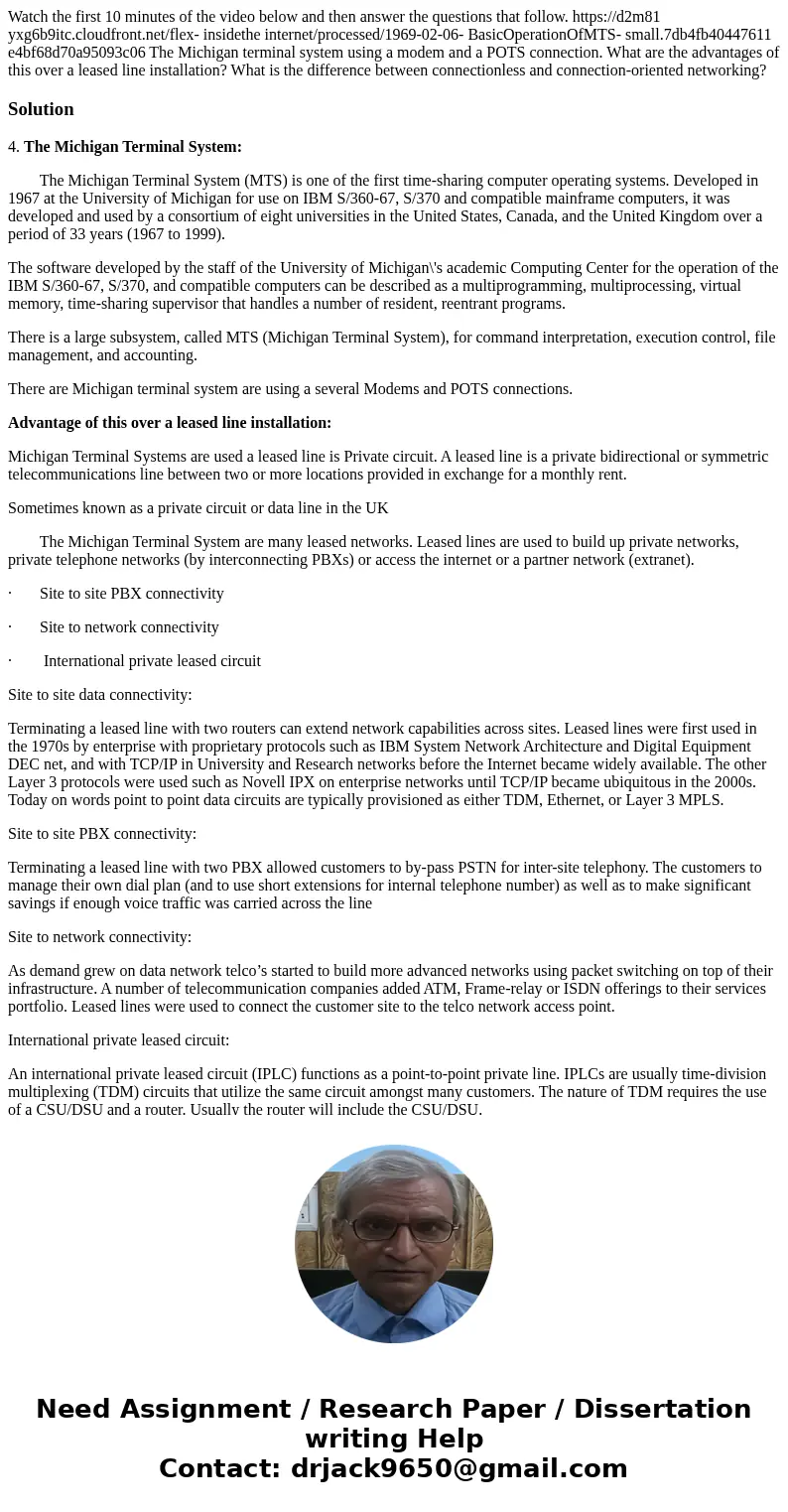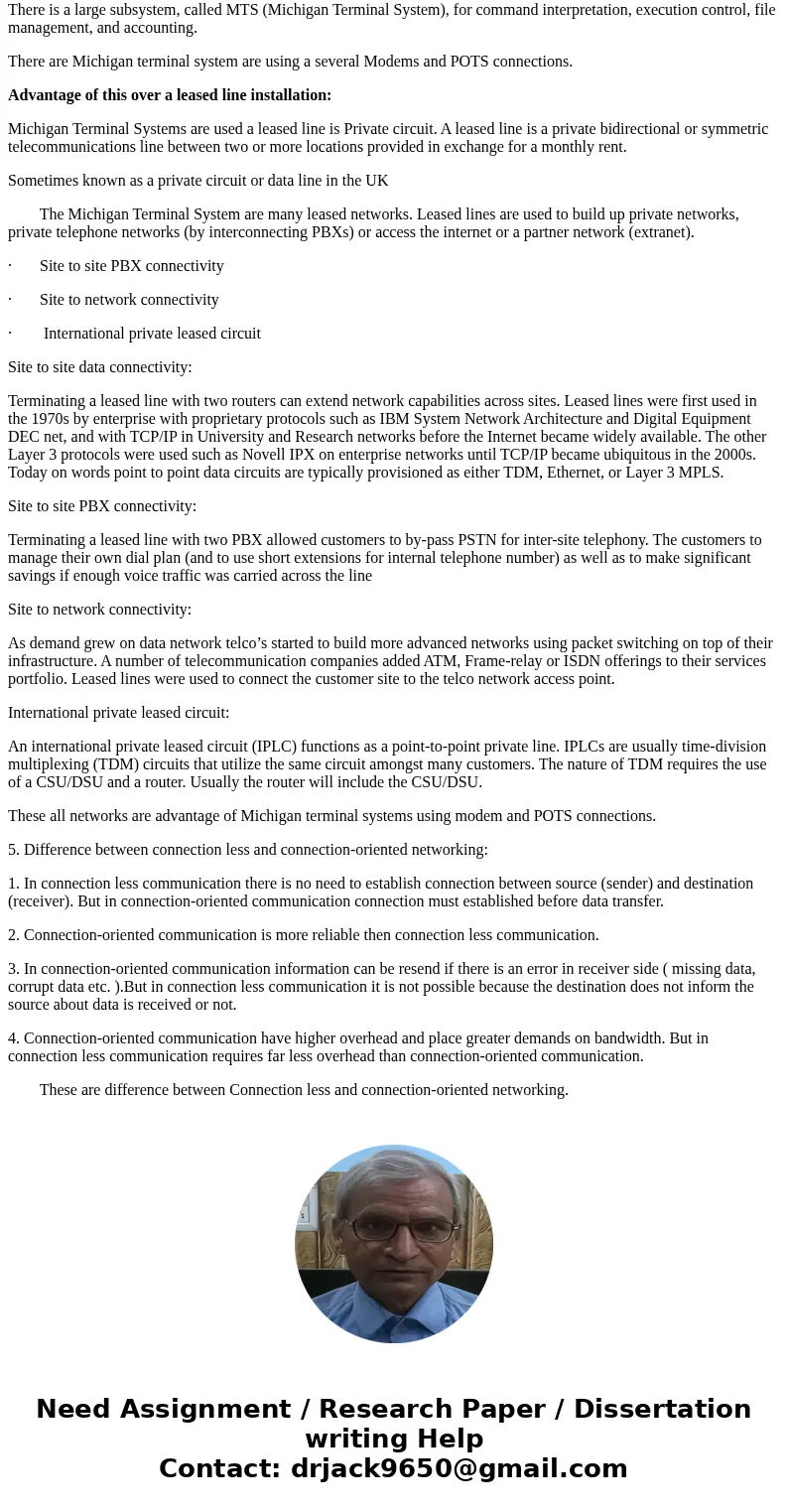Watch the first 10 minutes of the video below and then answe
Solution
4. The Michigan Terminal System:
The Michigan Terminal System (MTS) is one of the first time-sharing computer operating systems. Developed in 1967 at the University of Michigan for use on IBM S/360-67, S/370 and compatible mainframe computers, it was developed and used by a consortium of eight universities in the United States, Canada, and the United Kingdom over a period of 33 years (1967 to 1999).
The software developed by the staff of the University of Michigan\'s academic Computing Center for the operation of the IBM S/360-67, S/370, and compatible computers can be described as a multiprogramming, multiprocessing, virtual memory, time-sharing supervisor that handles a number of resident, reentrant programs.
There is a large subsystem, called MTS (Michigan Terminal System), for command interpretation, execution control, file management, and accounting.
There are Michigan terminal system are using a several Modems and POTS connections.
Advantage of this over a leased line installation:
Michigan Terminal Systems are used a leased line is Private circuit. A leased line is a private bidirectional or symmetric telecommunications line between two or more locations provided in exchange for a monthly rent.
Sometimes known as a private circuit or data line in the UK
The Michigan Terminal System are many leased networks. Leased lines are used to build up private networks, private telephone networks (by interconnecting PBXs) or access the internet or a partner network (extranet).
· Site to site PBX connectivity
· Site to network connectivity
· International private leased circuit
Site to site data connectivity:
Terminating a leased line with two routers can extend network capabilities across sites. Leased lines were first used in the 1970s by enterprise with proprietary protocols such as IBM System Network Architecture and Digital Equipment DEC net, and with TCP/IP in University and Research networks before the Internet became widely available. The other Layer 3 protocols were used such as Novell IPX on enterprise networks until TCP/IP became ubiquitous in the 2000s. Today on words point to point data circuits are typically provisioned as either TDM, Ethernet, or Layer 3 MPLS.
Site to site PBX connectivity:
Terminating a leased line with two PBX allowed customers to by-pass PSTN for inter-site telephony. The customers to manage their own dial plan (and to use short extensions for internal telephone number) as well as to make significant savings if enough voice traffic was carried across the line
Site to network connectivity:
As demand grew on data network telco’s started to build more advanced networks using packet switching on top of their infrastructure. A number of telecommunication companies added ATM, Frame-relay or ISDN offerings to their services portfolio. Leased lines were used to connect the customer site to the telco network access point.
International private leased circuit:
An international private leased circuit (IPLC) functions as a point-to-point private line. IPLCs are usually time-division multiplexing (TDM) circuits that utilize the same circuit amongst many customers. The nature of TDM requires the use of a CSU/DSU and a router. Usually the router will include the CSU/DSU.
These all networks are advantage of Michigan terminal systems using modem and POTS connections.
5. Difference between connection less and connection-oriented networking:
1. In connection less communication there is no need to establish connection between source (sender) and destination (receiver). But in connection-oriented communication connection must established before data transfer.
2. Connection-oriented communication is more reliable then connection less communication.
3. In connection-oriented communication information can be resend if there is an error in receiver side ( missing data, corrupt data etc. ).But in connection less communication it is not possible because the destination does not inform the source about data is received or not.
4. Connection-oriented communication have higher overhead and place greater demands on bandwidth. But in connection less communication requires far less overhead than connection-oriented communication.
These are difference between Connection less and connection-oriented networking.


 Homework Sourse
Homework Sourse